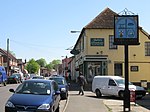Comarques, Thorpe-le-Soken
Grade II* listed buildings in EssexGrade II* listed housesHouses completed in the 18th century
Comarques is an 18th-century country house in Thorpe-le-Soken, Essex, England. It has been attributed to the architect, Sir Robert Taylor. Named after Captain Comarque, a Huguenot refugee who owned the estate in the early 18th century, the house is in the Queen Anne style. The author Arnold Bennett lived at Comarques between 1913 and 1921. There is a tradition that Clement Attlee lived at the house as a child, but Historic England does not support this claim. Comarques is a Grade II* listed building.
Excerpt from the Wikipedia article Comarques, Thorpe-le-Soken (License: CC BY-SA 3.0, Authors).Comarques, Thorpe-le-Soken
High Street, Essex
Geographical coordinates (GPS) Address External links Nearby Places Show on map
Geographical coordinates (GPS)
| Latitude | Longitude |
|---|---|
| N 51.8599 ° | E 1.1571 ° |
Address
High Street
CO16 0EG Essex, Thorpe-le-Soken
England, United Kingdom
Open on Google Maps








